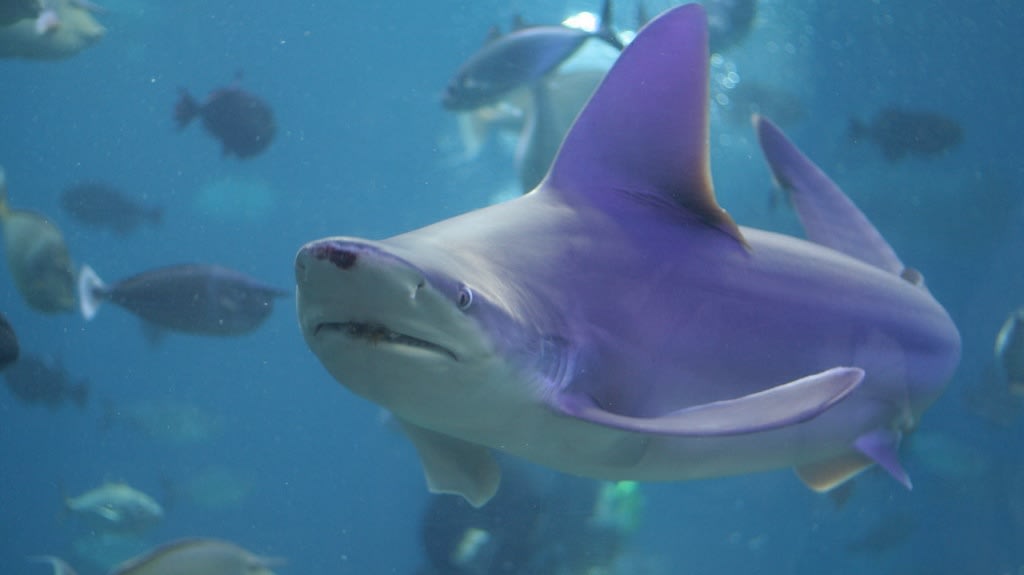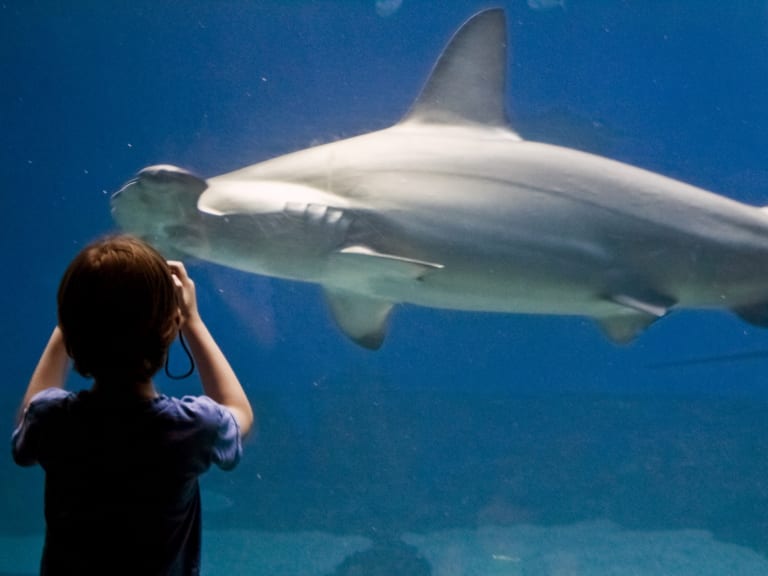Swim with Sharks in Maui
Ready for one of the most exciting experiences of your life? Here I'll tell you everything you need to know to enjoy swimming with sharks in Maui and have the most exciting vacation ever.

Shark in Maui | ©Justin Lint
As one of the most visited islands in Hawaii, you will find many activities to see, do, and enjoy in Maui, but none as extreme as observing a group of sharks up close.
Although many people perceive sharks as intimidating creatures, it is perfectly safe to swim with them if you are properly prepared and take the necessary precautions. For that reason, if your dream has always been to swim among these fabulous ancient creatures, Maui is the perfect place to do so because of its abundance of white tip reef sharks.
Swimming with sharks at Mala Pier in Lahaina

Considered by hundreds of travelers to be one of the best activities in Maui, you will find several local companies offering the experience of swimming with sharks at Mala Wharf in Lahaina.
Over the years, this place has become synonymous with safe encounters with sharks on the island.
The Mala Wharf pier in the city of Lahaina is also one of the best diving sites on the north coast of Maui. The depth of its waters reaches about 10 meters, making it an ideal diving spot for beginners and intermediate divers alike.
If you are looking to go diving in Maui, it is wise to know that shallow spots are ideal, as they allow divers to spend long periods of time underwater without exhausting their air supply. At Mala Wharf, you can dive for 45 minutes to an hour.
Here, you can even swim with sharks without a safety cage, as many of the white tip reef sharks live peacefully in this area because the pier serves as a protective shield where they can relax and take their daily naps.
The pier, known locally as Mala Wharf or Mala Pier, suffered a partial collapse in 1992 during Hurricane Iniki. Today, the fallen concrete posts serve as a shield and refuge for sharks and other species.
How to get there
The harbor is located north of Front Street on Mala Wharf Rd., just behind Longs at the Lahaina Cannery Mall.
Useful information
- Chance of seeing sharks: Considered the best place to see sharks in Maui, the chances exceed 90%.
- Price: This type of experience is available from approximately $150 per traveler.
- Duration of the experience: Depending on the company you hire, the experience can take 2 to 3 hours to complete.
- Is it advisable to book in advance? Yes, I recommend booking your diving experience in Lahaina in advance, as there are few specialized companies and spots fill up quickly.
Swim with sharks at the Maui Aquarium

When it comes to swimming with sharks in Maui, the Ocean Maui Center aquarium offers one of the best options.
This diving experience takes divers to swim among approximately 20 sharks, rays, and hundreds of fish in a controlled environment with certified professionals.
It is available on specific days and times by advance reservation. These days are Monday, Wednesday, and Friday starting at 2:30 p.m. If your stay on the island is short, 5 days in Maui or less, book your visit to the aquarium well in advance of your arrival.
All participants must meet a series of requirements, including: being at least 12 years old; presenting a diver's certification; having read the liability waiver; and having made a reservation in advance.
The Ocean Center Aquarium is also considered one of the best places to see turtles in Maui, so I recommend taking advantage of your visit to see these fabulous creatures.
How to get there
The Maui Ocean Center is located in Maalaea in the central part of the island. It is easy to get there by bus or private transportation from anywhere.
In addition, the port of Maalaea is the departure point for most excursions to visit Molokini Crater. If you want to make the most of your day, you can book both experiences for the same date.
Useful information
- Chance of seeing sharks: 100%, as they are in a controlled habitat.
- Price: The price for the shark swimming experience at the aquarium starts at €350 per participant. The aquarium provides all the necessary equipment for the experience.
- Duration of the activity: Approximately 3 hours.
- Is it advisable to book in advance? Yes**,** the aquarium requires participants to make their reservations at least 24 hours in advance. The reservation is non-refundable if you miss your appointment.
Swim with sharks at Kaanapali Beach

Airport Beach Maui is considered an excellent diving site for beginners and intermediate divers, and due to shark sightings, it is also considered a place in Maui where it is possible to observe some specific specimens.
However, keep in mind that sightings are occasional, so if your ultimate goal is to swim with sharks in Maui, I recommend choosing one of the two alternatives explored above in the post.
Airport Beach in Kaanapali is, on the other hand, an excellent place to hone your diving skills and swim among some of the most beautiful coral reefs on the island.
It's an excellent alternative if you want to explore other beaches in Maui or if you're going to Maui for your honeymoon and are looking for activities for couples.
How to get there
Kaanapali Beach is located north of Lahaina, towards the island's airport. Take Highway 30 past Kaanapali Parkway; at the bottom of the hill, turn left onto Kai Ala Dr. Your destination is opposite the Sugarcane Train station.
Useful information
- Chance of seeing sharks: Unfortunately, the odds are not very high, reaching only 5% in the best seasons.
- Price: Diving experiences in Kaanapali are available from €130 per participant.
- Duration of the experience: 2 to 3 hours depending on the company you hire for the experience.
What to expect from your first experience swimming with sharks

Your first experience with sharks should be fun and memorable. The team from the company you hire for the experience will take care of that and begin the diving adventure by teaching you the correct behaviors and safety measures for swimming with sharks.
During your diving experience in Maui, you can expect to see different species of sharks depending on the location you choose for the experience. You will also be able to see other creatures that coexist in the same natural habitat with these animals.
Although movies have led us to believe that sharks are aggressive and fearsome creatures, the reality is far from this fantasy. Sharks mainly feed on other fish, turtles, and seals.
When attacks occur, it is almost always because they mistake humans for one of their preferred food sources. All experienced divers who swim with sharks on a daily basis agree on one thing: sharks are quite tolerant of human presence and are not interested in including us in their diet.
Sharks are ancient dinosaur species that have remained on the planet with very few changes in their form and anatomy (beyond a reduction in size) for more than 400 million years. There are nearly 500 known species of sharks on the planet.
Safety tips for swimming with sharks in Maui

While it's true that swimming with sharks in Maui is an epic and memorable experience that you'll treasure for a lifetime, you should never, under any circumstances, compromise your safety or that of the people accompanying you.
Safety comes first, which is why I've compiled the most important considerations for you to remember before entering the water and while you're in it.
Wear the right wetsuit.
Your wetsuit should be a deep, dark color that resembles the colors of the ocean.
If possible, match your wetsuit with diving equipment of the same color to avoid contrasts and be as inconspicuous as possible.
Make sure you don't carry any bright objects or colors with you. Bright objects, such as accessories, can easily be mistaken for the reflection of fish scales, and bright colors such as yellow are generally associated with fish and food.
Always stay close to the group
Once in the water, avoid diving alone and stay close to the group, as this makes it very unlikely that sharks will take the initiative to approach.
Always follow the instructions of the guide in charge of the experience, for your own safety and that of the other people accompanying you.
Stay calm but remain alert
While you are in the water swimming with sharks, remember to stay calm and avoid sudden movements that could alarm your companions or the sharks. Maintaining a steady pace and making an effort not to make any noise are usually excellent practices.
All this without losing sight of the movements around you, because if you notice erratic behavior in any of the sharks, it is usually best for safety reasons to end the dive as soon as possible.
Sharks need their space
When engaging in this type of activity, always remember that you are an intruder in the sharks' habitat, so respecting their space is vital.
Keep a safe distance, because like any species in the animal kingdom, when a shark sees something approaching, it may attack in self-defense. If you swim towards a shark and it swims away, leave it alone!
Finally, do not stroke their heads or near their jaws, and please do not take photos with flash, as this may disturb them.
Avoid the early morning and late afternoon hours.
Most shark species are crepuscular in their feeding habits. This means that they feed mainly at dawn and dusk.
Consequently, avoid diving near them at dawn and dusk, both times of day when they are actively searching for food. However, midday in bright sunlight is usually a pretty good time to dive.
